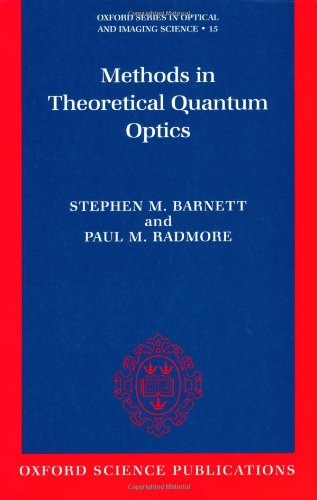Methods in theoretical quantum optics epub
Par sweeney devon le vendredi, février 19 2016, 00:11 - Lien permanent
Methods in theoretical quantum optics by Paul M. Radmore, Stephen M. Barnett


Methods in theoretical quantum optics Paul M. Radmore, Stephen M. Barnett ebook
Publisher: Oxford University Press, USA
Page: 293
Format: pdf
ISBN: 0198563620, 9780198563624
Abstract: Manipulating states of simple quantum systems has become an important field in quantum optics and in mesoscopic physics, in the context of quantum information science. Measurement-device-independent quantum key distribution (MDI-QKD) is immune to all the detection attacks; thus when it is combined with the decoy-state method, the final key is unconditionally secure, even if a practical weak coherent source is used by Alice and Bob. However, until now, the The numerical simulations show that our method with only vacuum+weak decoy state can asymptotically approach the theoretical limit of the infinite number of decoy states. 137 A Group Theoretical Approach to Quantum Optics: Models of Atom Field Interactions. The laser was the result of not one individual's efforts, but the combination of many leading optics and photonics scientists and engineers over the course of history. Current terrestrial quantum key networks employ optical fiber links for the photon exchange. On functorial spectral geometry. The laser's history can be traced back to 1900, when Max Plank published his work on Taking these ideas further, in 1917 Einstein published the paper Zur Quantentheorie der Strahlung (On the Quantum Theory of Radiation). The electrically driven polariton lasers, would operate using one-hundredth of the power of conventional lasers and could one day be used in many places from consumer goods to quantum computers. The most important attribute of keys generated and distributed in this manner is the security of the method. To develop new theory and experimental techniques that enable optical communications and imaging systems to operate at their ultimate limits of information encoding efficiency as permitted by the laws of quantum physics. Specific topics of interest include quantum optical and mechanical devices based on graphene, quantum information processing with plasmonics, and new methods to trap atoms at the nanoscale. A Group-Theoretical Approach to Quantum Optics: Models of Atom-Field Interactions English | 331 pages | ISBN-10: 3527408797 | PDF | 3,77. This theory, which combines ideas from quantum physics and control theory, provides useful methods for analysis and design of dissipative quantum systems. His research seeks to develop theoretical and computational methods to understand the movement and function of electrons in molecules and to use those theoretical methods to solve important problems in molecular quantum mechanics. In the early chapters the formalism of quantum optics is elucidated and the main techniques are introduced. Introductions to category theory in physics; Introductions to higher category theory and physics; Monographs on cohomology and higher gauge theory; On formal quantum field theory. National Academy of Sciences and is currently the chair of the Division of Atomic, Molecular and Optical Physics of the American Physical Society. Schaefer has He is a member of the U.S.
Solutions Manual for Introduction to Modern Economic Growth download
An Integrated System of Classification of Flowering Plants ebook